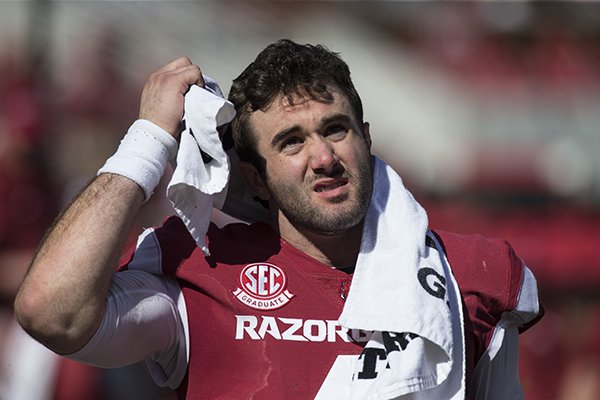FAYETTEVILLE — In reviewing his first season at Arkansas on Thursday, Chad Morris had a difficult time pinpointing what the Razorbacks hung their hat on offensively.
Morris estimated that Arkansas implemented only 30-35 percent of his playbook in Year 1 and, more than anything, tried to adapt and hone in on parts of the offense players could grasp.
Personnel issues, among other factors, plagued an offense that finished at or near the bottom of the SEC in a number of statistical categories and led to Morris' second 10-loss season in four years as a head coach. Between now and next fall, the Razorbacks will be searching for an identity.
"We’ve got to be able to grow our offense," Morris said. "I thought we did some things that took advantage of some of the speed on the edge at times. ... We’ve got to be able to have the speed at some of the positions that we’ve got to have. I’ve talked about that. Overall, did not think we were near fast enough."
Morris wants the Razorbacks to be a power-counter and inside-zone rushing team that can also stretch the field with explosive plays through the air. Arkansas' passing game rarely challenged opposing defenses, however, finishing last in the SEC in yards per attempt (6.18 yards) and next to last in completion percentage.
The 18 interceptions thrown by Arkansas quarterbacks – Ty Storey, Cole Kelley, Connor Noland, John Stephen Jones – are the most in a season since Casey Dick, Nathan Dick and Tyler Wilson combined for 18 in 2008.
La'Michael Pettway and tight end Cheyenne O'Grady were the Razorbacks' best, most frequently used weapons, each totaling 30 catches on the season. Pettway led the team with 503 receiving yards, but that number is the lowest by a leading receiver in a season since Morris became a head coach in 2015.
Jordan Jones, who starred in Arkansas' season-opening win against Eastern Illinois with five catches for 132 yards and a touchdown, caught only 12 passes for 59 yards over the final 11 games of the season. Mike Woods had his moments as a freshman as well, flashing great athleticism at times and catching 18 passes for 206 yards and a touchdown.
Morris added that there is a need for bigger-body type receivers in the future and that it is being addressed in recruiting. But, again, creating depth and advantages in space with speed is a focal point.
"To be able to run our offense at the level we want to run at we’ve got to have depth at wide receiver," Morris said. "When you go and you change from being a predominantly 12- or 13-personnel team and you’re going to predominantly 11 and some 12 ... we’re spreading it out, you create 1-on-1s. That’s where we’ve got to become faster and be able to separate ourselves coming in and out of breaks."
In terms of the running game, Rakeem Boyd, who recently had surgery on his left shoulder and was seen wearing a sling outside the Fred W. Smith Center on Thursday, led the team with 734 yards rushing and a pair of touchdowns. Devwah Whaley, who battled an ankle injury late in the season, finished with 368 yards and two more scores.
Arkansas, which ran the ball on 54 percent of its plays this season, was last in the SEC in rushing touchdowns and was the only school in the league to average fewer than one per game. Cole Kelley, used primarily in short-yardage scenarios once Ty Storey took over the role of starting quarterback, led the team with three touchdowns on the ground.
All in all, the Razorbacks were largely inefficient offensively, scoring on fewer than 28 percent of their drives and averaging a league-worst 1.55 points per possession despite leading the conference in possessions per game (14).
Turnovers and pass protection (one sack per 12.59 pass attempts) played a key role in the struggles as well. Fifteen percent of Arkansas' possessions resulted in a giveaway. No other team in the SEC had a turnover rate higher than 13 percent.
"I’ve been here before. I’m not going to deviate," Morris said pointedly. "I’ve got the blueprint, I’ve got the vision and it’s worked. It’s working at a very high level right now, but we’re not going to waver. I’m not going to look the other way."

